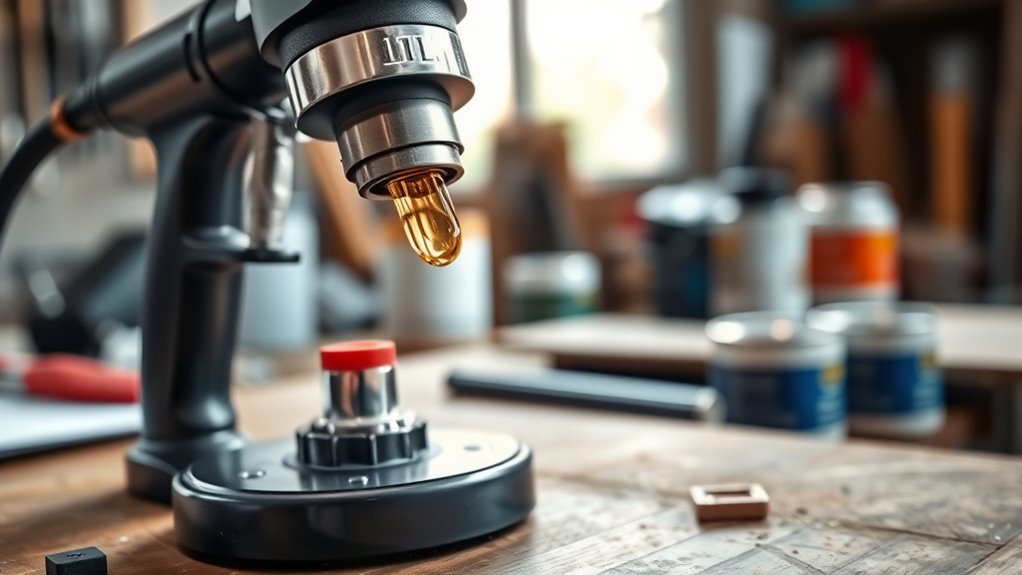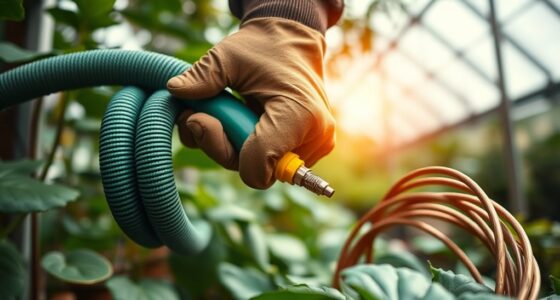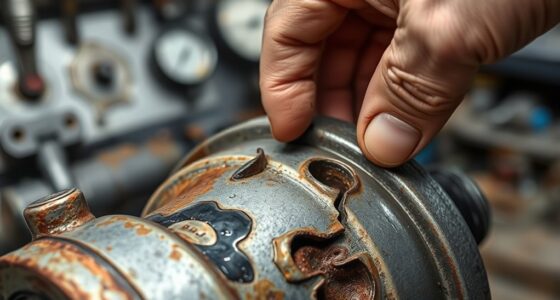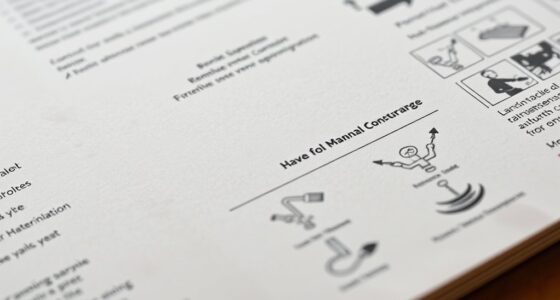To keep your paint sprayer running smoothly and last longer, regularly follow the manufacturer’s lubrication intervals and use the recommended oils or greases for each part. Apply lubricant before heavy use or after periods of inactivity, making sure not to over-lubricate, which can cause dirt buildup. Keep an eye out for leaks or unusual noises, and address lubrication issues promptly. Continuing will provide you with detailed steps to maintain peak performance and extend your equipment’s lifespan.
Key Takeaways
- Follow the manufacturer’s guidelines for lubrication intervals and recommended lubricant types.
- Regularly inspect for signs of inadequate lubrication, such as unusual noises or sluggish operation.
- Lubricate moving parts like pistons and gears before heavy use or after periods of inactivity.
- Apply the correct amount of lubricant, avoiding over- or under-lubrication, and wipe away excess.
- Replace lubricants periodically and monitor oil levels to ensure continuous optimal performance.
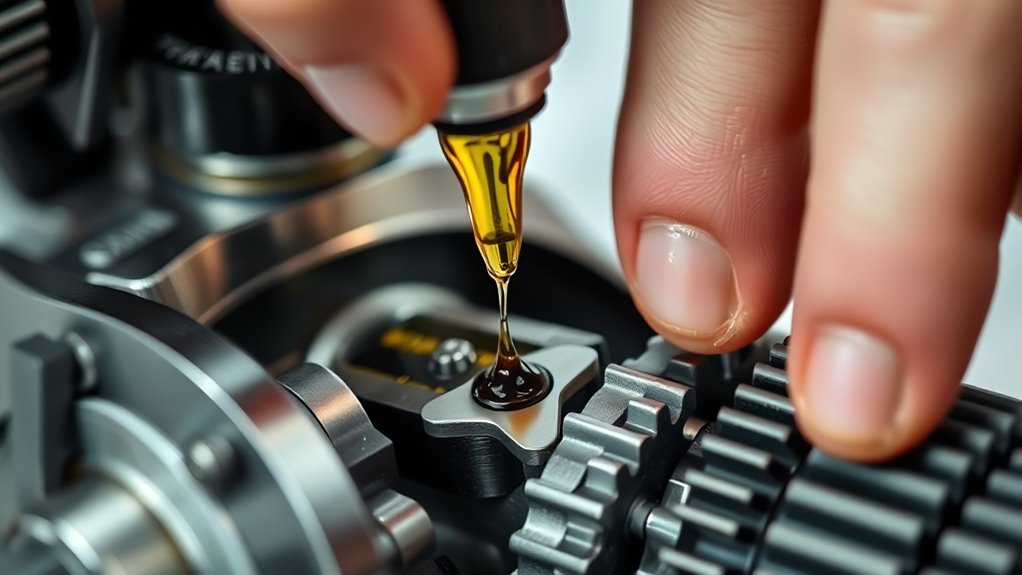
Proper lubrication is essential for keeping machinery running smoothly and preventing costly breakdowns. When it comes to your paint sprayer, maintaining proper lubrication ensures consistent performance and prolongs its lifespan. To achieve this, you need to understand the right maintenance tips and troubleshooting basics that keep your equipment in top shape. Neglecting lubrication can lead to increased wear and tear, clogged parts, or even complete failure of the sprayer, which can be costly and time-consuming to repair.
Proper lubrication ensures your paint sprayer runs smoothly and lasts longer.
First, always refer to the manufacturer’s guidelines on lubrication intervals and the type of lubricant recommended. Using the wrong oil or grease can cause damage rather than protect your equipment. Regularly inspect your paint sprayer for signs of inadequate lubrication, such as unusual noises, sluggish operation, or overheating. These are clear troubleshooting basics that tell you it’s time to lubricate or check for other issues. Keep a schedule to oil moving parts like the piston, seals, and any exposed gears, especially before heavy use or after long periods of inactivity.
Additionally, choosing the correct lubricant type ensures optimal performance and prevents damage. When applying lubricant, use a clean, appropriate amount—more isn’t always better. Over-lubricating can cause excess buildup, which might attract dirt or debris, leading to clogs or increased wear. Conversely, under-lubrication results in increased friction, which accelerates component degradation. Always wipe away excess oil to prevent dirt accumulation and keep parts clean. If your sprayer has specific lubrication points, make sure to focus on those areas during each maintenance session.
Troubleshooting basics also include checking for leaks or dried-out grease, which indicate the need for re-lubrication or part replacement. If you notice your sprayer isn’t functioning smoothly, don’t ignore these signs—address them promptly. Sometimes, a simple lubrication fix can solve issues like uneven spray patterns or inconsistent flow, saving you from more extensive repairs. Keep an eye on the oil levels and quality, and replace lubricants periodically to maintain peak performance.
Frequently Asked Questions
Can I Use Household Oil on My Paint Sprayer?
You might wonder if household oils are okay for your paint sprayer, but beware of lubrication myths. Using household oils isn’t recommended because they can clog or damage the internal parts. Stick to manufacturer-recommended lubricants designed for paint sprayers to guarantee smooth operation and longevity. Don’t fall for myths that all oils are the same; proper lubrication keeps your sprayer functioning well and prevents costly repairs down the line.
How Often Should I Lubricate the Internal Components?
You should lubricate the internal components of your paint sprayer based on the manufacturer’s recommended maintenance schedule. Typically, this means applying lubricant after every few use sessions or when you notice signs of stiffness or resistance. The lubrication frequency helps prevent wear and ensures smooth operation. Always follow your specific sprayer’s guidelines to maintain ideal performance and longevity, avoiding over-lubrication that could cause buildup or damage.
What Signs Indicate My Sprayer Needs Lubrication?
Many believe that squeaking or sticking indicates the need for lubrication, and you’re right. These signs show your paint sprayer needs maintenance. During regular paint sprayer maintenance, watch for decreased spray consistency, unusual noises, or stiffness in moving parts. Using proper lubrication techniques, like applying oil to key components, keeps your sprayer functioning smoothly. Addressing these signs promptly ensures longevity and peak performance, preventing costly repairs or downtime.
Is There a Specific Lubricant Recommended for Different Sprayer Models?
When it comes to sprayer maintenance, you’ll want to guarantee you use a lubricant compatible with your specific model. Check your manufacturer’s instructions for recommended lubricants, as using the wrong type could damage components. Generally, light machine oil or silicone-based lubricants work well. Always verify lubricant compatibility to keep your sprayer functioning smoothly and extending its lifespan. Proper maintenance helps prevent wear and ensures ideal performance.
Can Improper Lubrication Damage My Paint Sprayer?
Imagine you skip regular paint sprayer maintenance and neglect lubrication techniques. Over time, this can cause parts to wear out or seize, leading to costly repairs. Improper lubrication damages your sprayer by increasing friction, causing leaks, or motor failure. To avoid this, always follow recommended lubrication practices, oil when needed, and use the right lubricants for your model. Proper maintenance guarantees your paint sprayer stays smooth and efficient.
Conclusion
By keeping your paint sprayer properly lubricated, you’re nurturing its heart to beat steadily through every project. Think of lubrication as the gentle touch that extends its life and keeps it performing like new. Don’t let neglect turn your trusty tool into a rusted relic. With regular oiling, you’re not just maintaining equipment—you’re preserving a dependable partner in your creative journey. Treat it well, and it’ll reward you with flawless finishes for years to come.
Franz came aboard the Paint Sprayer Zone team with a background in both journalism and home renovation. His articulate writing style, combined with a passion for DIY projects, makes him an invaluable asset. Franz has a knack for breaking down technical jargon into easy-to-understand content, ensuring that even the most novice of readers can grasp the complexities of paint sprayers.
